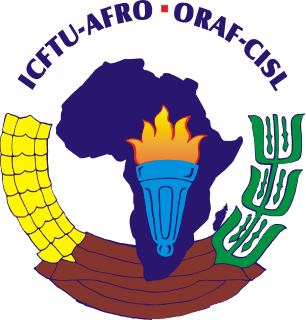Related Research Articles

The International Confederation of Free Trade Unions (ICFTU) was an international trade union. It came into being on 7 December 1949 following a split within the World Federation of Trade Unions (WFTU), and was dissolved on 31 October 2006 when it merged with the World Confederation of Labour (WCL) to form the International Trade Union Confederation (ITUC).

The World Federation of Trade Unions (WFTU) is an international federation of trade unions established in 1945. Founded in the immediate aftermath of World War Two, the organization built on the pre-war legacy of the International Federation of Trade Unions as a single structure for trade unions world-wide. With the emergence of the Cold War in the late 1940s, the WFTU splintered, with most trade unions from the Western-aligned countries leaving and creating the International Confederation of Free Trade Unions (ICFTU) in 1949. Throughout the Cold War, membership of the WFTU was made up predominantly of trade unions from the Soviet-aligned and non-aligned countries. However, there were notable exceptions to this, such as the Yugoslav and Chinese unions, which departed following the Tito-Stalin and Sino-Soviet splits, respectively, or the French CGT and Italian CGIL unions, who were members. With the end of the Cold War and the dissolution of the Soviet Union, the WFTU lost the largest portion of its membership and financial support. Since the start of the 2000s, the organization shifted headquarters to Athens and recruited new members, claiming to have grown from representing 48 million workers in 2005 to 105 million in 2022.

The World Confederation of Labour (WCL) was an international labour organization founded in 1920 and based in Europe. Totalitarian governments of the 1930s repressed the federation and imprisoned many of its leaders, limiting operations until the end of World War II. In 2006 it became part of the International Trade Union Confederation (ITUC), ending its existence as an independent organization.
The ITUC Regional Organisation for Asia and Pacific is a regional organisation of the International Trade Union Confederation representing trade unions from countries in Asia and Oceania. It has 40 affiliated organisations in 28 countries, claiming a membership of 30 million people.

The International Trade Union Confederation (ITUC) is the world's largest trade union federation.

The ICFTU African Regional Organisation (AFRO) was a regional organisation of the International Confederation of Free Trade Unions (ICFTU), representing trade unions from countries in Africa.

The ICFTU Asia and Pacific Regional Organisation (APRO) was a regional organisation of the International Confederation of Free Trade Unions (ICFTU), representing trade unions from countries in Asia and Oceania.

The ICFTU Inter American Regional Organisation of Workers was the regional organization of the International Confederation of Free Trade Unions (ICFTU) for the Americas.
Confédération africaine des syndicats libres, initially 'Confédération africaine des syndicats libres-Force ouvrière, was an Africa confederation of trade unions. CASL-FO was founded in February 1958 as the African sections of the French trade union centre CGT-Force Ouvrière separated themselves from their mother organization. The new union confederation was founded at a conference in Abidjan February 8–9, 1958, with participation of the CGT-FO branches of Senegal, French Soudan, Upper Volta, Niger, Ivory Coast, Cameroon, Moyen-Congo and Ubangui-Shari. At the time of the founding of CASL-FO, the relationship of the new structure with the International Confederation of Free Trade Unions (ICFTU) and CGT-FO, was debated. In the end the conference resolved that CASL-FO and CGT-FO should have membership of ICFTU on equal footing.
The Somali Confederation of Labour was a national trade union centre in Somalia. CSL was founded in 1949. CSL was closely linked to the ruling Somali Youth League, but retained organizational independence.
The South African Congress of Trade Unions (SACTU) was a national trade union federation in South Africa.
The Liberian Federation of Trade Unions was a trade union centre in Liberia.
Amos N. Gray was a Liberian trade unionist. Born in Pull River, Maryland County, Gray attended primary school in Pull River and secondary school in Harper. He attended college in Monrovia, studying social studies for two years and law for one year. During his college years he worked part-time at the Freeport of Monrovia. Working at the port in 1960, he joined the Maritime and Dock Workers Union. After his college years he worked at the Maritime and Dock Workers Union office in Monrovia.
Desigar Ramanujam was a Ceylonese trade unionist and politician.

The International Federation of Plantation and Agricultural Workers (IFPAAW) was a global union federation bringing together unions representing land workers.
Joe-Fio Neenyann Meyer was a Ghanaian diplomat and trade unionist.

Palayil Pathazhapurayil Narayanan was a Malaysian trade unionist.
The International Landworkers' Federation (ILF) was a global union federation bringing together trade unions representing agricultural and forestry workers.
The ICFTU European Regional Organisation (ERO) was a regional trade union confederation, bringing together national federations of trade unions in Europe.
References
- 1 2 Seminar on the Role of Women Workers in the Plantation Economy . Role of Women Workers in the Plantation Economy. Colombo: Sri Lanka Foundation Institute, 1979. p. 50
- 1 2 3 Congress Proceedings . International Confederation of Free Trade Unions. 1960. p. 73
- 1 2 3 Docherty, J. C., and Jacobus Hermanus Antonius van der Velden. Historical Dictionary of Organized Labor . Lanham, Md: Scarecrow Press, 2012. pp. 141-142
- 1 2 3 4 Congress Proceedings . International Confederation of Free Trade Unions. 1960. p. 205
- ↑ Congress Proceedings . International Confederation of Free Trade Unions. 1960. p. 605
- 1 2 ILF Bulletin . International Landworkers' Federation. 1957. p. 18
- 1 2 Report on Activities - Postal, Telegraph and Telephone International , Vol. 25, 1981–1984. p. 22
- 1 2 3 Report of Proceedings at the 91st Annual Trades Union Congress . Trades Union Congress. 1959. p. 210
- 1 2 Woodworkers, Painters & Buildingworkers Journal . 1960. p. 136
- ↑ Report of Proceedings of the National Committee . Amalgamated Engineering Union. 1960. pp. 116-117
- ↑ Marsh, Arthur Ivor. Trade union handbook . Farnborough, Hants: Gower Pr, 1979. p. 68
- ↑ Report of the Congress: And Report on Activities and Financial Report . International Landworkers' Federation. 1959. p. 15